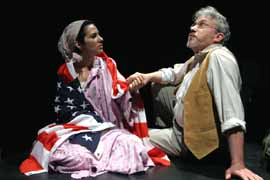
ROBERT HICKS
Charles L. Mee's "Time To Burn" and Maxim Gorky's "The Lower Depths"
Manhattan Ensemble Theater, 55 Mercer St.
at Broome St., June 4-27.
Closed June 27
Presented by Resonance Ensemble
Review by Robert Hicks on June 21 ("Time
To Burn") and on June 23 ("The Lower Depths").
 |
| Annette Previti & Lou Tally in "Time to Burn". Photo by: Rahav Segev/Photopass.com |
Charles L. Mee borrows heavily in his retelling of Maxim Gorky's classic "The Lower Depths," which originally opened at the Moscow Art Theater in 1902. But plot similarities are not the whole problem with the American experimental dramatist's portrayal of homeless people gathered together in an abandoned factory in his 1997 adaptation play, "Time To Burn."
The problem lies in Mee's lack of character development. There's Jessie, an African-American bag lady who collects snuffboxes, sea shells and opera glasses, but has lost her father's desk and sings spirituals. She finally resigns to placing her faith in God. Alejandro, a flamboyant transvestite, unsettles his cohabitants with his tales of homosexuality. An irritable Pole, Jaroslaw, and his ill wife, Anna, still place their faith in capitalism. Schlomo, a wandering Jew, carries a volume of Lenin, speaks poetically about a woman's pulse and offers sage insights about life. With the exception of the relationship between Anna and Schlomo, these characters remain mere stereotypes whose interaction offers little reason to believe they can spark social change in America.
 |
| Emily Laochua, Maxwell Zener, Stu Richel, James T. Ware in "The Lower Depths." Photo by: Rahav Segev/Photopass.com |
The New York premiere of "Time To Burn" (presented by the inexperienced
Resonance Ensemble in repertory with "The Lower Depths") suffered
from an uneven cast of non-professional actors and professional Actors Equity
members. The staging for "Time To Burn" was very static and the
lighting was very unprofessional in the performance I saw on June 21. When
one of the elder actors has to ask for a lighting cue in the middle of the
play, you know you're in trouble. The cast for "The Lower Depths"
did prepare more thoroughly for its performance on June 23. Still, the acting
was uneven at times. Gorky's portrayal of vagabonds, addicts, thieves, unemployed
workers and fallen aristocrats still commands the interest of both the heart
and mind. After all, the play did presage the breakdown of class distinctions
that led to revolution in Russia. Unlike Mee's characters, who lack spiritual
guidance, Gorky's lost souls have failed to preserve their sense of self-identity.
In such a world, there is no hope for the future. There wasn't much hope for
either of these spiritless productions, but artistic director Eric Parness's
direction of "The Lower Depths" was at least somewhat engaging unlike
Leland Patton's static, albeit sometimes humorous, direction of "Time
To Burn." Nevertheless, I suppose there is some merit in bringing these
two plays together in repertory. Let's just hope better productions of these
plays can grace New York stages in the future.[Hicks]
| museums | NYTW mail | recordings | coupons | classified |
